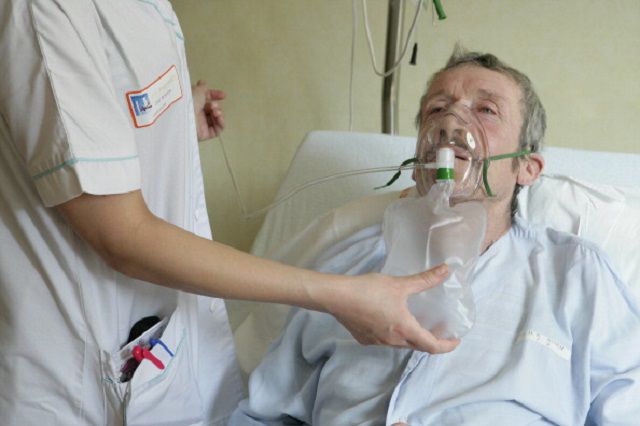Oxygen Therapy When should supplemental oxygen be prescribed?
Oxygen Therapy When should supplemental oxygen be prescribed?
Dr. Adel Salah
Professor of Respiratory Medicine
Zagazig University
Therapy
Long-standing hypoxemia can cause many adverse effects, including pulmonary hypertension, cor pulmonale, erythrocytosis, reduced exercise tolerance, neuropsychiatric impairment, and, most importantly, decreased survival.
Pathophysiological effects of hypoxia
Oxygen is essential for cell metabolism and lack of oxygen causes cell injury by:
- Adenosine triphosphate (ATP) depletion
- Intracellular acidosis
- Build-up of metabolic byproducts and free radicals
- Direct cell damage including to membranes and cytoskeleton
- Induction of inflammation
1- Acute oxygen therapy
- Cardiac or respiratory arrest or in acute life-threatening situations (e.g. acute severe asthma).
- CODP, acute exacerbation.
2- Long term oxygen therapy
. Continuous oxygen
- Resting room air Pa02 < 55 mmHg or Sa02 < 88%
- Resting Pa02 = 5659- mmHg or Sa02 <89% in the presence of any of the following:
- Edema suggesting congestive heart failure or P pulmonale on ECG.
- Erythrocytosis (i.e., hematocrit 56% or more);
. Noncontinuous oxygen
- Oxygen flow rate and number of hours per day must be specified
- During exercise: Pa02 < 55 mmHg or Sa02 < 88% with a low level of exertion
- During sleep: Pa02 < 55 mmHg or Sa02 < 88% with associated complications (i.e., pulmonary hypertension, daytime somnolence, or cardiac arrhythmias).
- More than a 5% fall in saturation during sleep.
Medicare requirements for long-term oxygen therapy
- The laboratory, not the oxygen supplier, must measure Pa02 or Sa02 (or both).
- The patient must have optimal medical management and must be clinically stable before, certification.
- There must be recertification and retesting in 6190- days if the patient has an initial Pa02 of 5659- mmHg and a saturation of 89%. All other patients need recertification after 12 months.
Should supplemental oxygen be prescribed for individuals with hypoxemia due to causes other than COPD?
Yes. Although the indications and benefits of supplemental oxygen have been studied best for individuals with COPD, other hypoxemic individuals should also be considered as candidates for supplemental oxygen. Examples of such patients include those with idiopathic pulmonary; fibrosis, kyphoscoliosis, or cystic fibrosis.
How should an oxygen prescription be written?
Once the need for supplemental oxygen is established, a prescription can be written. It should include:
• The qualifying arterial blood gas.
• The type of delivery system to be used (e.g., a stationary system, portable or ambulatory equipment, or an oxygen-conserving device).
• The delivery device (i.e., a nasal cannula, a transtracheal catheter, or a mask).
• The liter flow under specific conditions (i.e., sleep, rest, and exercise).
• The patient's diagnosis.
What systems exist to provide supplemental oxygen?
Compressed oxygen is provided in high-pressure cylinders. They are large and heavy and cause injury because of their high pressure if the valve end of the tank is damaged.
H or G tanks "2 L/min for 2 days.
D and E tanks "2 L/min for 4 hours
Liquid oxygen systems: Liquid oxygen is stored at
-183°C; as the tanks warm up, the oxygen expands, requiring pressure-relief valves, which waste unused oxygen. An advantage of liquid systems is that patients may fill their own tanks from the stationary system.
Stationary systems of liquid
oxygen " 2 L/min for 7 days.
Portable liquid systems " for times longer than compressed oxygen cylinders at a given flow rate.
The major disadvantage of liquid oxygen systems is their high cost and thermal burns if the liquid oxygen is accidentally poured on the skin.
Oxygen concentrators are electric devices that use either a molecular sieve or a semipermeable membrane. The molecular sieve separates oxygen from the air for delivery to the patient and returns nitrogen to the atmosphere. This device can deliver more than 90% oxygen at flows of up to 4 L/min.
What is an oxygen delivery device?
Low-flow systems (nasal cannula and face masks)
High flow system (venture masks)
What oxygen delivery devices are available?
Nasal Cannula " 16- L/min = 24% - 44%
Simple mask " 78- L/min = 50% - 60%
Partial rebreathing mask " 9 L/min = 70%
Nonrebreathing mask " 1012- L/min = 80% - 100%
Venturi mask " 2 – 16 L/min = 24%-60%
Is humidification of supplemental oxygen necessary?
Medical gases are essentially anhydrous (i.e., without water) and therefore require artificial humidification. Humidification of inhaled gas should be provided when flows are > 4 L/min.
Can high-flow oxygen be administered through nasal cannula?
- Salter
- Vapotherm
What are oxygen-conserving devices?
- Reservoir systems.
- Demand delivery systems
- Transtracheal catheters.
How is oxygen therapy monitored and adjusted?
Oxygen therapy is best monitored by arterial blood gas or pulse oximetry measurements with target values of Pa02 > 60 mmHg and a pulse oximetry measurement (Sp02) > 90%.
Are there risks associated with providing supplemental oxygen?
- Effects of supplemental oxygen on ventilation.
- Pulmonary oxygen toxicity.
- Absorption atelectasis.
- Retinopathy of prematurity.
- The morbidity associated with various oxygen delivery devices.
- Complications of transtracheal catheter.
- Risks related to using a combustible substance like oxygen.
How should patients receiving supplemental oxygen be transported within the hospital?
Patients receiving low-flow oxygen at 16- L/min can be transported using a portable liquid vessel of oxygen.
Higher flows (i.e., more than 6 L/min) require the use of a compressed gas cylinder, usually size E.



 info@utopiapharma.com
info@utopiapharma.com
 Plot No. (2) Industrial Zone (A7) - formerly Zizinia - Cairo - Ismailia Road - 10th of Ramadan - Sharkia
Plot No. (2) Industrial Zone (A7) - formerly Zizinia - Cairo - Ismailia Road - 10th of Ramadan - Sharkia